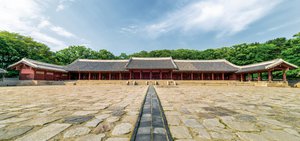UNESCO Heritage in Korea
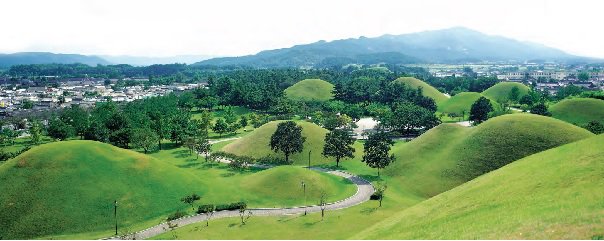
UNESCO Heritage in Korea
Korea’s vibrant cultural legacy, comprising music, art, literature, dance, architecture, clothing, and cuisine, offers a delightful combination of tradition and modernity. South Korea preserves a wealth of priceless cultural heritage, the majority of which have been inscribed on UNESCO’s World Heritage List to be protected for future generations.
Since the earliest settlements during prehistoric times, the people of Korea have developed a unique culture based on their outstanding artistic sensibility. The geographical conditions of the peninsula provided Koreans with opportunities to receive both continental and maritime cultures and ample resources, thereby forming original cultures of interest to and value for the rest of humanity, both then and now. Korea’s vibrant cultural legacy, comprising music, art, literature, dance, architecture, clothing, and cuisine, offers a delightful combination of tradition and modernity.
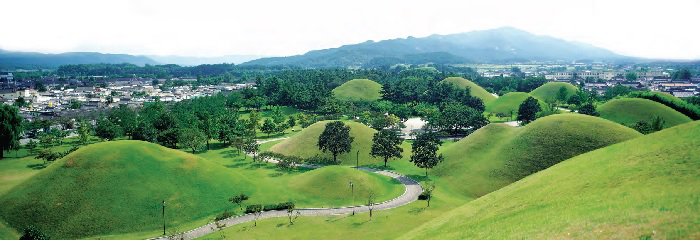
- Gyeongju Historic Areas
Gyeongju was the capital of Silla for about one millennium. The city still contains a wealth of archaeological remains from the kingdom, and hence is often dubbed as “a museum without walls or roof.” The photo shows a scene of the Silla mound tombs located in the city
At the present time, Korean arts and culture are attracting many enthusiasts around the world. Korea’s cultural and artistic achievements through the ages are now leading many of its young talents to the world’s most prestigious music and dance competitions, while its literary works are being translated into many different languages for global readers. Recently, Korean Dansaekhwa (monochrome paintings) have become the talk of the global art world.
The world’s craze for K-pop reached its zenith in August 2020, when the South Korean boy band BTS achieved its first No. 1 on the Billboard Hot 100 songs chart with its first all-English-language single entitled “Dynamite.” BTS has become the first all-South Korean act to top the Billboard Hot 100, as well as the first one in Asia since 1963. This outcome reflects the popularity of K-pop throughout the world, including the United States, South America, and Europe, as well as Japan, China, and Southeast Asia, rather than just a feat of a specific group. It is in the same context that music videos of K-pop stars such as BLACKPINK, a South Korean girl group, have recorded explosive views on YouTube and become more popularized.
As such, the artistic excellence of globally recognized Korean culture was not built overnight. The original artistic sensibility reflected in the diverse artifacts and tomb murals of the Three Kingdoms Period became richer and more profound as Korea progressed through the periods of Unified Silla (676–935), Goryeo (918– 1392), and Joseon (1392–1910). In addition, the DNA of this artistic sensibility has been handed down through the generations to today’s Korean people.
South Korea preserves a wealth of priceless cultural heritage, the majority of which have been inscribed on UNESCO’s World Heritage List to be protected for future generations. As of 2020, a total of 50 South Korean heritage items are listed either as World Heritage Sites or Intangible Cultural Heritage of Humanity, or included in the UNESCO’s Memory of the World Register.
Changdeokgung Palace
Changdeokgung Palace, located in Waryong-dong, Jongno-gu, Seoul, is one of the five Royal Palaces of the Joseon dynasty (1392–1910), and still contains the original palace structures and other remains intact. It was built in 1405 as a Royal Villa but became the Joseon dynasty’s official Royal Residence after Gyeongbokgung, the original principal palace, was destroyed by fire in 1592 when Japanese forces invaded Korea. Thereafter, it maintained its prestigious position until 1867, when Gyeongbokgung was renovated and restored to its original status. Changdeokgung was listed as a UNESCO World Heritage site in 1997.
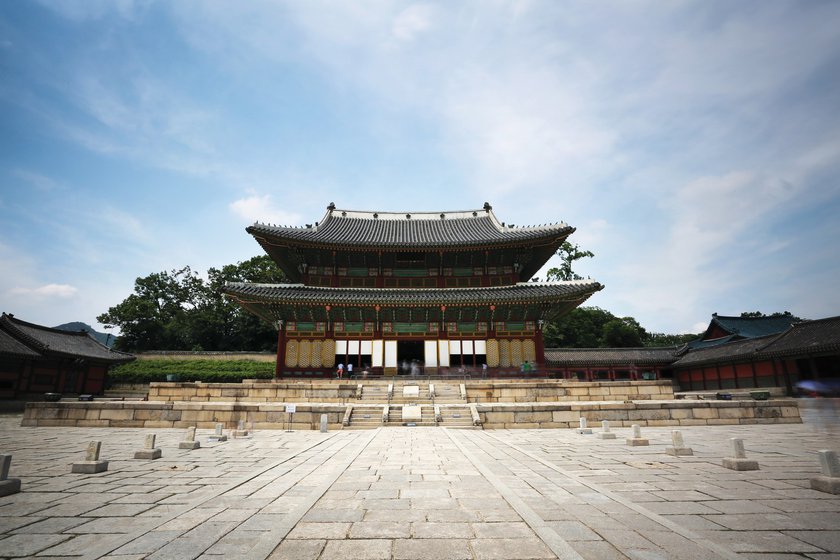
Although it was built during the Joseon dynasty, Changdeokgung shows traces of the influence of the architectural tradition of Goryeo, such as its location at the foot of a mountain. Royal palaces were typically built according to a layout planned to highlight the dignity and authority of its occupant, but the layout of Changdeokgung was planned to make the most of the geographical features of Eungbong Peak of the ridge of Bukakdan Mountain. The original palace buildings have been preserved intact, including Donhwamun Gate (the main gate at the entrance of Changdeokgung), Injeongjeon Hall, Seonjeongjeon Hall, and a beautiful traditional garden to the rear of the main buildings. Located inside Changdeokgung Palace, Nakseonjae is a compound of exquisite traditional buildings set up as a residence for members of the royal family.
Jongmyo Shrine
Jongmyo, located in Hunjeong-dong, Jongno-gu in Seoul, is the royal ancestral shrine of the Joseon dynasty (1392–1910). It was built to house 83 spirit tablets of the Joseon kings and their queen consorts, and direct ancestors of the dynasty’s founder who were posthumously invested with royal titles. As Joseon was founded based on Confucianism, the rulers considered it very important to put Confucian teachings into practice and sanctify the institutions where ancestral memorial tablets were enshrined.
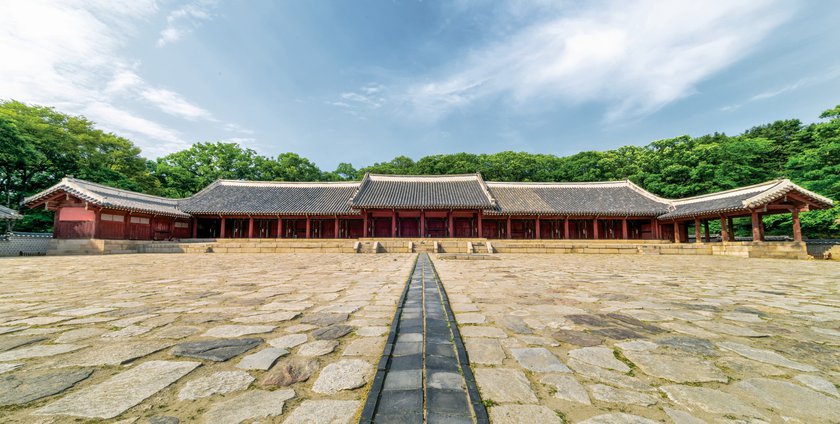
The two main buildings at the Royal Shrine, Jeongjeon Hall and Yeongnyeongjeon Hall, exhibit a fine symmetry, and there are differences in the height of the raised platform, the height of the eaves and the rooftop, and the thickness of the columns according to their status. The entire sanctuary retains its original features, including the two shrine halls, which exhibit the unique architectural style of the 16th century. Seasonal memorial rites to commemorate the life and achievements of the royal ancestors of the Joseon dynasty are still performed at the shrine.
Hwaseong Fortress
Located in today’s Jangan-gu, Suwon-si, Gyeonggi-do, Hwaseong Fortress is an impressive structure stretching for 5.7 km and was built in 1796 during the reign of King Jeongjo (r. 1776–1800) of the Joseon dynasty. The construction of the fortress was begun after the King moved the grave of his father, Crown Prince Sado, from Yangju in Gyeonggi-do to its current location near the fortress. The fortification is structured rationally and practically to effectively perform its function of protecting the city enclosed within it. The fortress and related facilities are well-known for having been constructed by means of scientific devices developed by the distinguished Confucian thinker and writer Jeong Yak-yong (1762–1836), including the Geojunggi (a type of crane) and Nongno (pulley wheel) used to lift heavy building materials such as stones.
Seokguram Grotto and Bulguksa Temple
Seokguram, located on the middle slope of Tohamsan Mountain in Gyeongju, Gyeongsangbuk-do, is the representative stone temple which was completed in 774 to serve as a dharma hall. This grotto is the product of outstanding architectural techniques. It is placed in such a way that the first rays of the sun rising over the East Sea would strike the forehead of the seated Buddha statue in the rotunda.
Completed the same year as Seokguram Grotto, Bulguksa Temple consists of exquisite prayer halls and various monuments, including two stone pagodas, Dabotap Pagoda and Seokgatap Pagoda, standing in the front courtyard of the temple’s main prayer hall called Daeungjeon. The two pagodas are widely regarded as the finest extant Silla pagodas: the former is admired for its elaborately carved details, the latter for its delightfully simple structure.
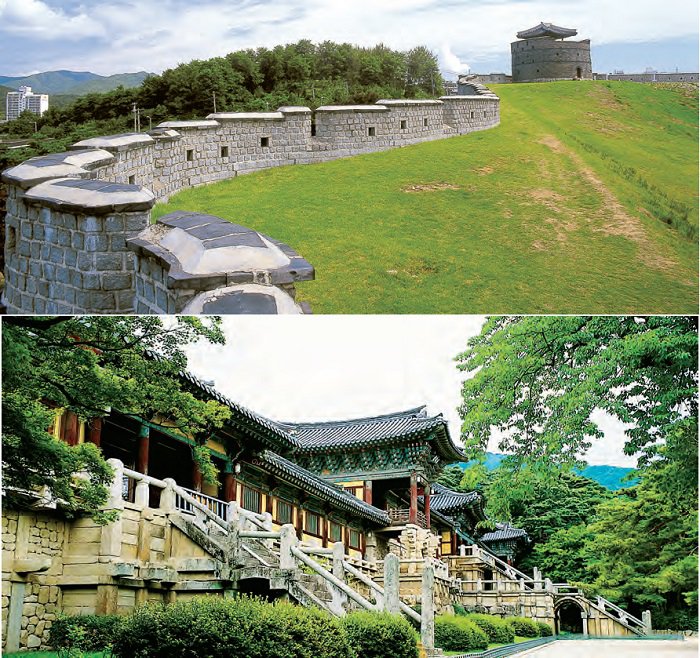
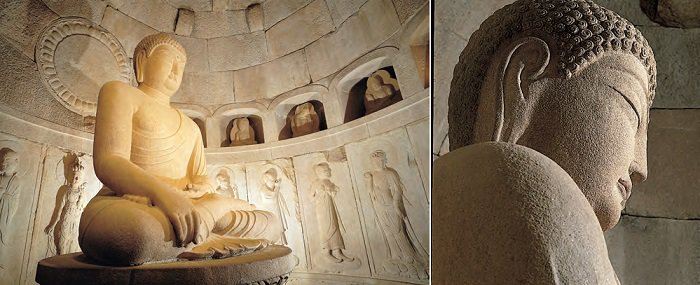
- Hwaseong Fortress: This fortification was built for defensive purposes, based on military construction techniques from both the East and West, at that time.
- Bulguksa Temple: This Silla temple is architecturally known for being one of the finest examples that embody the Buddhism doctrines. The photo shows Cheongungyo (Blue Cloud Bridge) and Baegungyo (White Cloud Bridge).
Dabotap, or the Pagoda of Abundant Treasures, is marked by a unique structure built with elaborately carved granite blocks. It also features the face of the Korean 10 won coin. By contrast, Seokgatap, or the Pagoda of Shakyamuni, is better known for its delightfully simple structure, which exhibits fine symmetry and balance. This pagoda is now generally regarded as the archetype of all the three-story stone pagodas built across Korea thereafter.
Among the other treasures preserved at the temple are the two exquisite stone bridges, Cheongungyo (Blue Cloud Bridge) and Baegungyo (White Cloud Bridge), leading to Daeungjeon, the temple’s principal dharma hall. These bridges symbolize the journey every Buddhist needs to make to reach the Pure Land of Bliss.
Royal Tombs of the Joseon Dynasty
The Joseon dynasty (1392–1910) left behind a total of 44 tombs of its kings and their queen consorts, most of which are located in and around the capital area including the cities of Guri, Goyang, and Namyangju in Gyeonggi-do. Some of these royal tombs are arranged in small groups in the Donggureung, Seooreung, Seosamneung, and Hongyureung. Of these, 40 tombs are registered as UNESCO World Heritage sites.
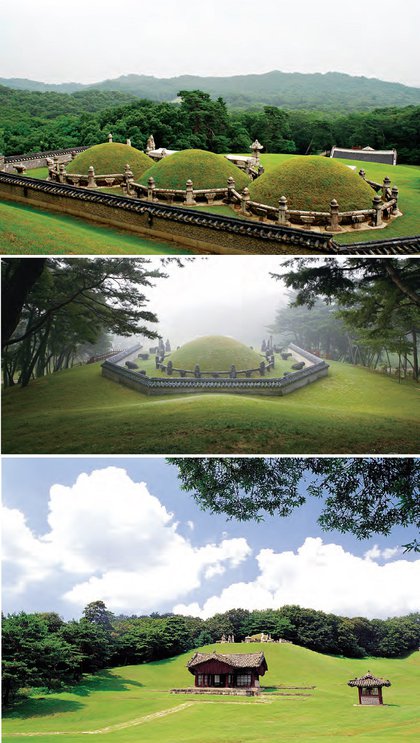
- Donggureung
A cluster of 9 neungtype tombs of 7 kings and 10 queen consorts and concubines who reigned during the Joseon dynasty period. - Yeongneung
The tombs of King Sejong and his consort Queen Soheon. - Mongneung
The tombs of King Seonjo and his consorts, Queen Uiin and Queen Inmok.
The Royal Tombs of the Joseon Dynasty are highly regarded as tangible heritage reflecting the value of Joseon funeral customs, which were derived from Confucianism and geomancy. It is worth noting that these historical remains have been preserved in their original conditions.
Haeinsa Temple Janggyeong Panjeon, the Depositories for the Tripitaka Koreana Woodblocks
The Printing Woodblocks of the Tripitaka Koreana, which was made during the Goryeo period (918–1392), are housed in the Janggyeong Panjeon complex specially made for that purpose in 1488 at Haeinsa Temple. As the oldest remaining buildings at the temple, the Tripitaka depositories are marked by the uniquely scientific and highly effective method of controlling ventilation and moisture to ensure the safe storage of the age-old woodblocks. The buildings were built side by side at the highest point (about 700 m above sea level) in the precincts of Haeinsa Temple, which is located on the mid-slope of Gayasan Mountain.
What makes these depositories so special is their unique design, which provides effective natural ventilation by exploiting the wind blowing in from the valley of Gayasan Mountain. The open lattice windows of different sizes are arranged in upper and lower rows on both the front and rear walls of the depositories to promote the optimum flow of air from the valley. Similarly, the floor, which was built by ramming layers of charcoal, clay, sand, salt, and lime powder, also helps to control the humidity of the rooms.
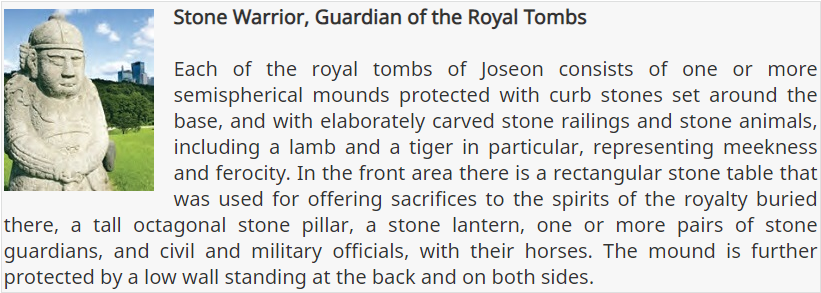
- Stone Warrior, the Guardian of the Royal Tombs
The Royal Tombs of the Joseon Dynasty feature one or more semispherical mounds protected with curbstones set around the base and elaborately carved stone railings and stone animals such as a lamb and a tiger, in particular, both of which represent meekness and ferocity. In the front area is a rectangular stone table that was used to offer sacrifices to the spirits of the royalty buried there. On both sides of the table stand tall octagonal stone pillars, which can be seen in the distance. In addition, stone lanterns are located in front of the stone animals. One or more pairs of stone guardians (civil and military officials) stand on both sides of each stone lantern, with their horses being behind them. The mound is further protected by a low wall standing at the back and on both sides.
Namhansanseong
Namhansanseong located about 25 km southeast of Seoul, was originally constructed in 672 as Jujangseong Fortress in the Unified Silla era, and later was restructured in 1626 during the reign of King Injo of the Joseon dynasty to create a refuge for the King and his people in the event of a national emergency.

The defensive position of the fortress was reinforced by exploiting the rugged topography of the mountain (average height: at least 480 m). The perimeter of its wall is about 12.3 km. According to a record dating back to the Joseon period, about 4,000 people lived in the town built inside the fortress, which also served as a temporary capital for the royal family and military commands to take refuge in during emergencies. Accordingly, temporary palaces, the Jongmyo shrine, and Sajikdan Altar were built in the fortress in 1711 during the reign of King Sukjong of Joseon.
This fortress is also understood as the important evidence of the wide-ranging exchange of architectural techniques used for fortification through wars between Korea (Joseon), Japan (Azuchi-Momoyama Period), and China (Ming and Qing), which lasted during the 16th–18th centuries. The introduction of cannons from western countries brought many changes to the weaponry inside the fortress and the way the fortress was built. The fortress is a “living record” that shows the changes in the fortification technique methods by era from the 7th–19th centuries.
Baekje Historic Areas
Baekje, one of the three ancient kingdoms on the Korean Peninsula, existed for 700 years from 18 BCE to 660 CE. Baekje Historic Areas comprise the eight cultural heritages located in Gongju-si, Buyeo-gun, and Iksan-si. They are the Gongsanseong Fortress and the Royal Tombs in Songsan-ri in Gongju-si, Chungcheongnam-do; the Archeological Site in Gwanbuk-ri, Busosanseong Fortress, the Royal Tombs in Neungsan-ri, the Jeongnimsa Temple Site, and the Naseong City Wall in Buyeo-gun, Chungcheongnam-do; and the Archaeological Site in Wanggung-ri and the Mireuksa Temple Site in Iksan-si, Jeollabuk-do.
These archaeological sites represent the historical relationships among the East Asian ancient kingdoms of Korea, China, and Japan from the 5th to the 7th centuries, and the resulting architectural development and spread of Buddhism. The Buddhist temples, ancient tombs, architecture, and stone pagodas are a testament to the culture, religion, and aesthetics of the Baekje kingdom.
Seowon, Korean Neo-Confucian Academies
Seowon were educational institutions intended to teach Neo-Confucianism, which was introduced from China and flourished greatly during the Joseon dynasty. Most were established from the mid-16th to 17th centuries. It comprises nine representative seowon: Sosuseowon, Namgyeseowon, Oksanseowon, Dosanseowon, Piramseowon, Dodongseowon, Byeongsanseowon, Museongseowon, and Donamseowon Confucian Academies, all of which are located across the central and southern parts of South Korea. They are recognized as an exceptional testimony to the excellent Neo-Confucianism and educational culture of Korea.
The local literati led seowon and made a significant contribution to the development and prosperity of seowon-centered culture in the Joseon dynasty. The local literati at seowon created educational systems and tangible structures so that their younger scholars could devote themselves to learning. Learning, veneration, and interaction were the essential functions of the seowon, which are closely reflected in their design.
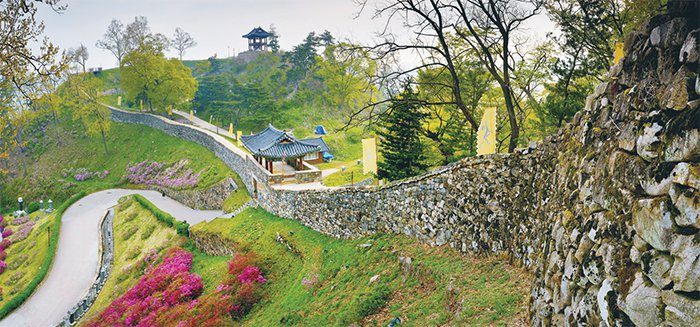
- Gongsanseong Fortress: A fortress, which was built along the mountain ridge and valley near the Geumgang River, initially called Ungjinseong during the Baekje period but later renamed Gongsanseong after the Goryeo period.
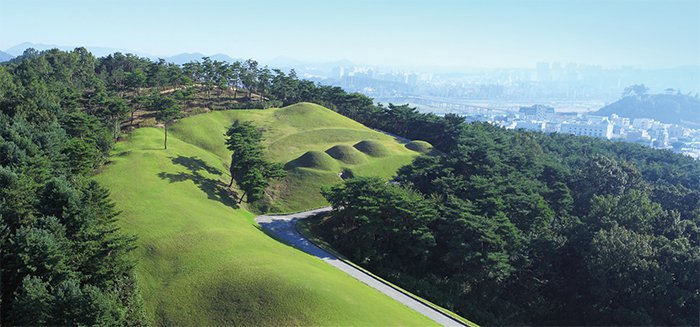
- Royal Tombs in Songsan-ri: The Songsan-ri tombs contain the graves of kings and royal families during the Ungjin period (475–538), seven of which have been restored including the Tomb of King Muryeong.
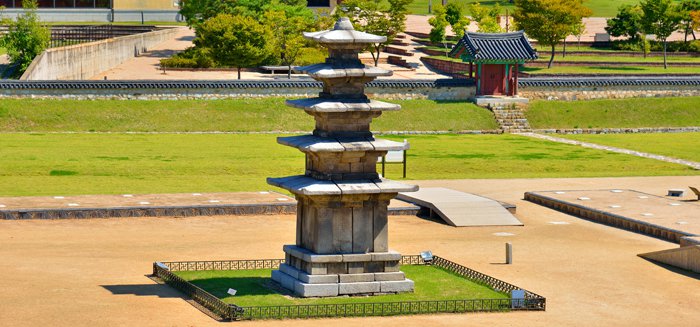
- Jeongnimsa Temple Site: Located in Dongnam-ri, Buyeo-eup, the temple site has a five-story stone pagoda and a stone seated Buddha from the Baekje period.
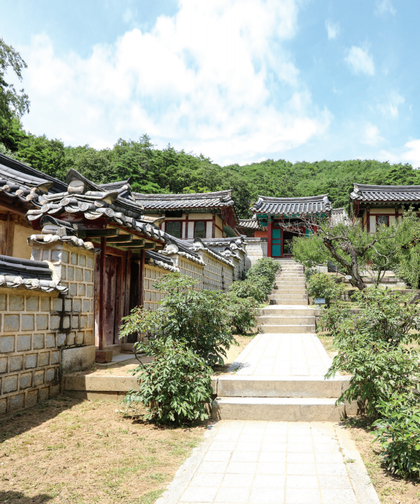
- Dosanseowon Confucian Academy: Dosanseowon is a Confucian academy, which was built in 1574 to commemorate and honor the learning and virtues of Yi Hwang (1501–1570), a scholar of the mid-Joseon dynasty
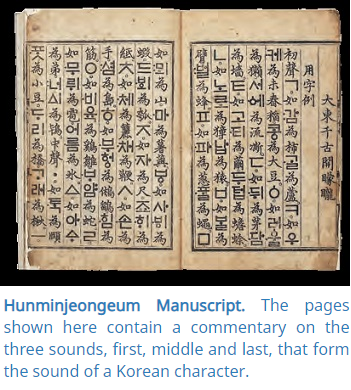
- Yongjarye in the Hunminjeongeum Manuscript: The pages shown here contain the examples of the Korean language at that time in 94 words for the three sounds, first, middle and last, that form the sound of a Korean character.
Hunminjeongeum (The Proper Sounds for the Instruction of the People)
Hangeul is the name of the Korean writing system and alphabet, which consists of letters inspired by the shapes formed by the human vocal organs during a speech, making it very easy to learn and use. Hangeul was promulgated in 1446 by King Sejong, who helped devise it and named it Hunminjeongeum, or The Proper Sounds for the Instruction of the People. It was also in that same year that he ordered his scholars to publish The Hunminjeongeum Haeryebon (Hunminjeongeum Manuscript) to provide detailed explanations of the purpose and guiding principles of the new writing system. One of these manuscripts is currently in the collection of the Kansong Art Museum and was included in UNESCO’s Memory of the World Register in 1997.
The invention of the Hunminjeongeum opened up a broad new horizon for all the Korean people, even women and those in the lowest social class, enabling them to learn to read and write and express themselves fully. Hunminjeongeum originally consisted of 28 letters, but only 24 are used now.
Seungjeongwon Ilgi: Diaries of the Royal Secretariat
This collection of documents contains the records of the Joseon rulers’ public life and their interactions with the bureaucracy; they were made on a daily basis by the Seungjeongwon, or Royal Secretariat, from the third month of 1623 to the eighth month of 1910. The records are collected in 3,243 diaries and include the details of royal edicts, reports, and appeals from ministries and other government agencies. The diaries are currently kept in the Kyujanggak Institute for Korean Studies, Seoul National University.
Ilseongnok: Records of Daily Reflections
vast collection of daily records made by the kings of the late Joseon period (from 1760 to 1910) is compiled in a total of 2,329 volumes. The records provide vivid and detailed information on the political situation in and around Korea and the ongoing cultural exchanges between the East and the West from the 18th to the 20th century.
Uigwe: The Royal Protocols of the Joseon Dynasty
This collection of beautifully illustrated books contains official manuals recording the details of court ceremonies or events of national importance for the purpose of future reference. The most frequently treated subjects in these books are royal weddings, the investiture of queens and crown princes, state and royal funerals, and the construction of royal tombs, although other state or royal occasions such as the “Royal Ploughing,” construction or renovation of palace buildings, are included. As for the latter, those published to mark the construction of Hwaseong Fortress and King Jeongjo’s formal visit to the new walled city in the late 18th century are particularly famous. These publications were also stored in the history depositories, sadly resulting in the destruction of early Joseon works by fire during the Japanese Invasion of Korea in 1592. The remaining 3,895 books of Uigwe were published after the war, some of which were stolen by the French Army in 1866 and kept in the Bibliothèque Nationale de France until 2011, when they were returned to South Korea following an agreement between the governments of South Korea and France.
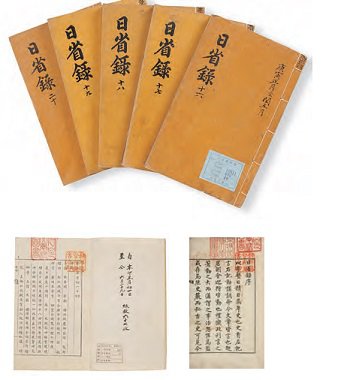
- Ilseongnok (Joseon, 18th–20th Centuries): Private journals concerning personal daily activities and state affairs kept by the rulers of late Joseon from 1760 to 1910
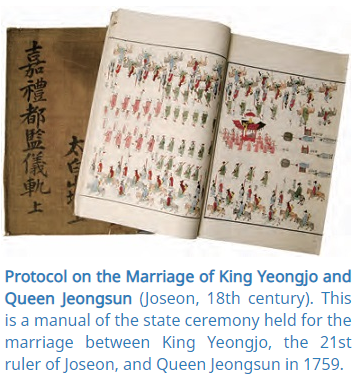
- Protocol on the Marriage of King Yeongjo and Queen Jeongsun (Joseon, 18th century): Garye refers to a royal wedding or enthronement of the king, and particularly, garye dogam uigwe refers to records about a wedding or formal installation of a crown prince or his eldest son, or the prince imperial or his son. This is a manual of the state ceremony held for the marriage between King Yeongjo, the 21st ruler of Joseon, and Queen Jeongsun in 1759
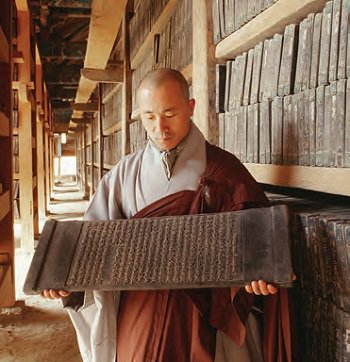
- Tripitaka Koreana Woodblocks: A total of over 80,000 woodblocks carved with the entire canon of Buddhist scriptures, showing the flow and aspects of politics, culture, and philosophy during the Goryeo dynasty
Printing Woodblocks of the Tripitaka Koreana and Miscellaneous Buddhist Scriptures
The collection of Tripitaka woodblocks stored at Haeinsa Temple (established 802) in Hapcheon-gun, Gyeongsangnam-do, was made during the Goryeo period (918–1392) under a national project that started in 1236 and took 15 years to complete. The collection is generally known by the name Palman Daejanggyeong, literally “the Tripitaka of 80,000 woodblocks,” as it consists of 81, 258 blocks of wood.
The Tripitaka Koreana woodblocks were made by the people of Goryeo who sought the Buddha’s magical power to repel the Mongol forces that had invaded and devastated their country in the 13th century. The Tripitaka Koreana is often compared with other Tripitaka editions produced by the Song, Yuan, and Ming dynasties in China, and has been highly praised for its richer and more complete content. The process of manufacturing the woodblocks played an important role in the development of printing and publication techniques in Korea.
Human Rights Documentary Heritage 1980 Archives for the May 18th Democratic Uprising against Military Regime, in Gwangju
The May 18 Democratization Movement was a popular uprising that took place in the city of Gwangju from May 18 to 27, 1980, during which Gwangju’s citizens made a strong plea for democracy in Korea and actively opposed the then military dictatorship. This pro-democracy struggle in Gwangju ended tragically but exerted a powerful influence on similar democratic movements that spread across East Asia in the 1980s. This UNESCO records consist of the documents, videos, photographs, and other forms of records made about the activities of Gwangju’s citizens during the movement, and the subsequent process of compensation for the victims, as collected by the May 18 Memorial Foundation, the National Archives of Korea, Republic of Korea Army Headquarters, the National Assembly Library of Korea, and various organizations in the United States.
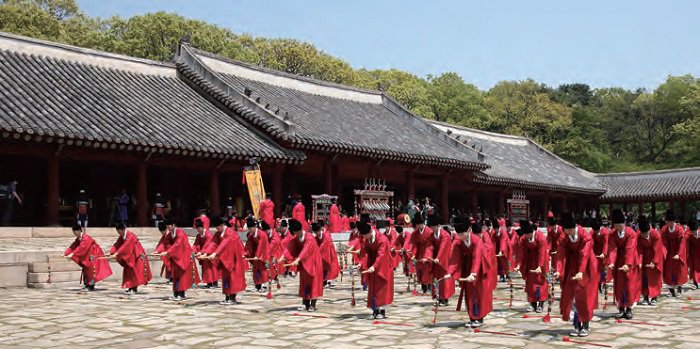
- Jongmyo Jeryeak (Royal ancestral ritual music in the Jongmyo shrine):
The Royal ancestral ritual held seasonally at the Jongmyo shrine involves the performance of the civil and military dances munmu and mumu. The former features quiet and gentle moves while the latter strong and powerful ones.
Royal Ancestral Ritual in the Jongmyo Shrine and Its Music
The Royal ancestral ritual (Jongmyo Jerye) in the Jongmyo shrine is now held on the first Sunday of May to honor the deceased Joseon kings and their queen consorts at the Jongmyo shrine in Seoul. It was the most important state ceremony designed to maintain the social order and promote solidarity and the practice of duties as a human after the establishment of Joseon as a Confucian state in 1392.
This ritual consists of performances of ceremonial orchestral music (Jerye-ak) and graceful and fancy dance moves (munmu and mumu) praising the civil and military achievements of the royal ancestors of Joseon. This age-old Confucian ritual combining splendid performances of music and dance is widely admired not only for the preservation of the original features for over 500 years but also for its unique syncretic and composite art form.
Pansori Epic Chant
Pansori is a genre of musical storytelling performed by a vocalist and a single drummer in which he or she combines singing (sori) with gestures (ballim) and narrative (aniri) to present an epic drama conceived from popular folk tales and well-known historic events. The art form was established during the 18th century and has generated enthusiastic performers and audiences ever since.
Gangneung Danoje Festival
This festival is held in Gangneung, Gangwon-do, for about 30 days until Dano Day on the fifth day of the fifth lunar month. It is one of Korea’s oldest folk festivals and has been preserved more or less in its original form since its emergence many centuries ago. The festival starts with the traditional ritual of honoring the mountain god of Daegwallyeong and continues with a great variety of folk games, events, and rituals during which prayers are offered for a good harvest, the peace and prosperity of villages and individual homes, and communal unity and solidarity.
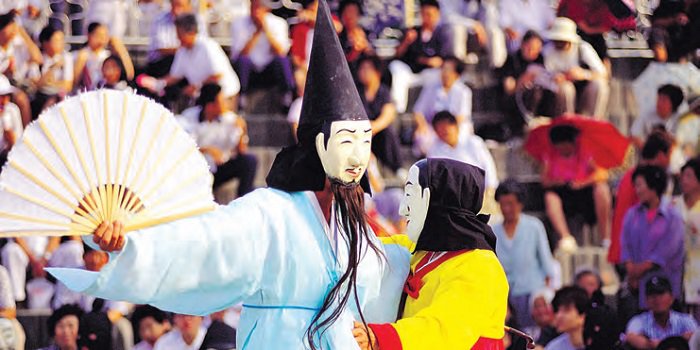
- Gangneung Danoje Festival
A masked couple dancing at the Gwanno Mask Dance during the Gangneung Danoje Festival, a traditional local festival held from the fourth month to the fifth month of the year according to the lunar calendar.
The first event of the Danoje Festival is related to the preparation of “divine drinks” (sinju) to be offered to gods and goddesses, thus linking the human world with the divine world. This is followed by a variety of festive events such as the Gwanno Mask Dance (Korea’s unique nonverbal performance by masked players), swing riding, ssireum (Korean wrestling), nongak (traditional Korean music performed by farmers) contests, changpo (iris) hair washing, and surichwi rice cake eating. Of these, the changpo hair washing event is particularly widely practiced by women who believe that the extract of changpo will give them glossier hair and repel the evil spirits that are thought to bear diseases.
Ganggangsullae
This traditional event combining a circle dance with singing and folk games was performed by women around the coastal areas of Jeollanam-do during traditional holidays such as Chuseok (Harvest Moon Festival/Thanksgiving) and Jeongwol Daeboreum (the first full moon of the New Year on the lunar calendar), in particular. While today, the dance part is selected to be performed by professional dancers, the original performance included several different folk games such as Namsaengi nori (Namsadang vagabond clowns’ play), deokseok mori (straw mat rolling), and gosari kkeokgi (bracken shoot picking). The performers sing the Song of Ganggangsullae as they dance, and the singing is done alternately by the lead singer and the rest with the tempo of the song and dance movements becoming faster and faster toward the end.
Namsadang Nori
Namsadang nori, generally performed by an itinerant troupe of male performers, consists of several distinct parts including pungmul nori (music and dance), jultagi (tightrope walking), daejeop dolligi (plate spinning), gamyeongeuk (mask theater), and kkokdugaksi noreum (puppet theater). The performers also played instruments while they dance, such as the barrel buk (drum), janggu (hourglassshaped drum), kkwaenggwari (small metal gong), jing (large metal gong), and two wind instruments called nabal and taepyeongso. It was intended to reduce fatigue and increase cooperation during hard work such as weeding, weeding a rice paddy, rice-planting, etc.
Yeongsanjae
Yeongsanjae is a Korean Buddhist ritual performed on the 49th day after one’s death, which is to guide the soul of the deceased to the Pure Land of Ultimate Bliss (Buddhist paradise). The ritual, known to have been performed since the Goryeo dynasty (918–1392), aims to enlighten both the dead and the living about Buddha’s teachings so that they can be freed from all defilement and suffering. Its value as a Buddhist ritual lies in the engagement of the public rather than a unilateral performance. It is also performed as a Buddhist ceremony to pray for the peace of the country and the well-being of the people.
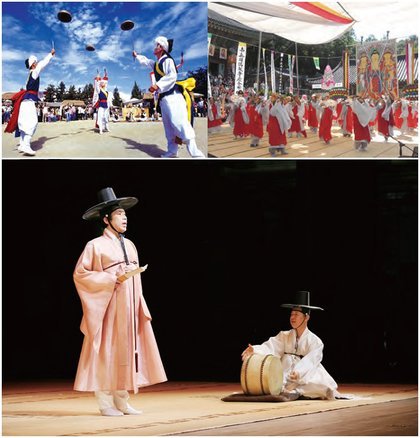
- Namsadang Nori
Performance presented by a traveling troupe of about 40 performers led by a percussionist called Kkokdusoe. - Yeongsanjae
A Buddhist memorial ritual performed on the 49th day after one’s death to guide the spirit to the pure land of bliss. - Pansori
Performance of a solo artist assisted by a drummer where singing is combined with dramatic narratives and gestures to present a long, epic story (National Center for Korean Traditional Performing Arts).
Jeju Chilmeoridang Yeongdeunggut
This age-old shamanic ritual was at one time performed in almost all the towns and villages in Jeju Island, with worshippers praying for a good catch and the safety of fishermen working at sea. According to the traditional folk belief of Jeju islanders, the second lunar month is the month of Yeongdeung, during which Grandma Yeongdeung, a wind deity, visits all the villages, farming fields, and homes across Jeju Island, bearing tidings about the harvest in the oncoming autumn.
Taekkyeon, A Traditional Korean Martial Art
One of the surviving traditional martial arts developed in Korea, Taekkyeon, which is different from taekwondo historically and technically, used to be known by several different names such as Gakhui (“sport of legs”) and Bigaksul (“art of flying legs”). Such names suggest that it is related with the movement of kicking. Like most other martial arts in which weapons are not used, Taekkyeon is aimed at improving one’s self-defense techniques and promoting physical and mental health through the practice of orchestrated dance-like bodily movements, using the feet and legs in particular. Compared to other martial arts, Taekkyeon focuses more on defensive techniques than on offensive ones, characterized by fluid, dynamic foot movement. The way of playing the match is simple. To be a winner, the fighters knock the opponent down with their hands and feet or jump up and kick the other on the face, while maintaining a stance where one foot is placed in front of the other, pointing to the opponent.
Jultagi, Tightrope Walking
In the traditional Korean art of jultagi (tightrope walking), a tightrope walker performs a variety of acrobatic movements, as well as singing and comic storytelling, as he walks on a tight rope. He is generally assisted by an eorit gwangdae (clown) on the ground who responds to his words and movements with witty remarks and comic actions intended to elicit an amused response from the spectators. Tightrope walking was formally performed at the royal court to celebrate special occasions such as the (Lunar) New Year’s Day or to entertain special guests such as foreign envoys. However, the aspiration of Joseon’s rulers toward a more austere lifestyle gradually pushed it toward villages and markets, and it ultimately became entertainment for the common people. While tightrope walking in other countries tends to focus on the walking techniques alone, Korean tightrope walkers are interested in songs and comedy as well as acrobatic stunts, thereby involving the spectators more intimately in the performance.
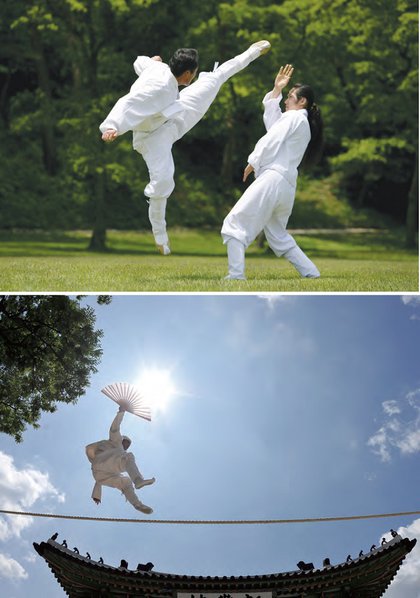
- Taekkyeon
A traditional Korean martial art marked by elegant yet powerful physical movements. - Jultagi
Traditional Korean performance of tightrope walking combined with jokes, mimicry, songs, and dance along with acrobatic movements.
Falconry, A Living Human Heritage
Korea has a long tradition of keeping and training falcons and other raptors to hunt wild pheasants or hares. Archaeological and historical evidence shows that falconry on the Korean Peninsula started several thousand years ago and was widely practiced during the Goryeo period (918–1392) in particular. The sport was more popular in the north than in the south, and usually conducted during the winter when farmers were available. Falconers would tie a leather string around the ankle of their bird and an identification tag and a bell to its tail. The Korean falconry was inscribed on the Representative List of the Intangible Cultural Heritage of Humanity in 2010 jointly with falconry preserved in 11 other countries around the world, including the Czech Republic, France, Mongolia, Spain, and Syria.
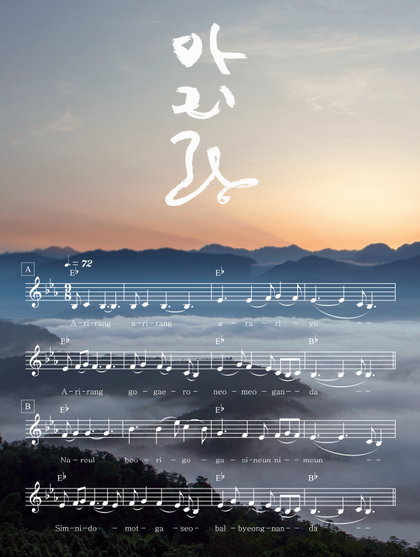
Arirang, Lyrical Folk Song in the Republic of Korea
Arirang is a Korean folk song that represents Korean culture. It is not a single song but has been handed down in different versions by region. At present, there are an estimated 3,600 variations of 60 different versions of “Arirang.”
Arirang has been created together by people over several generations. As anyone can create new lyrics and melodies, it has been handed down in various versions tailored to local characteristics. The most famous Arirang versions include “Jeongseon Arirang” originating in Gangwon-do, “Jindo Arirang” in Jeollanam-do, and “Miryang Arirang” in Gyeongsangnam-do. Although the melodies and lyrics vary in each region, all of them include a refrain similar to “arirang” or “arari” in common.
The contents of the song are as diverse as the versions. They are sung in different situations and for purposes. In other words, they can be sung to soothe the difficulties of farming, to confess one’s true heart to one’s beloved, to pray for an affluent and peaceful life, and to entertain people gathered for a celebration. One thing in common is that the song embodies the emotions of joy, anger, sorrow, and pleasure that people feel in their daily lives. The lyrics and melodies of Arirang depend on a singer’s situations, and this characteristic has provided a catalyst for enriching the diversity of Korean culture.
Today, Arirang is sung at important national events, playing a role in unifying the Korean people. For example, the Korean national team sang the song when they entered the stadium at the 27th Olympic Summer Games: Sydney 2000. Also, during the 2002 FIFA World Cup Korea/Japan, Red Devils, the official supporting group for the Korea Republic national football team, sang Arirang to cheer up their national football team.
Kimjang, Making and Sharing Kimchi
Kimjang is the activity of making kimchi that is conducted all over Korea during late autumn as part of the preparations to secure fresh, healthy food for the winter season. Now gaining a worldwide reputation as a representative Korean food, kimchi has always been one of the key side dishes required to complete the everyday meals eaten by Korean people since olden times. That is why kimjang has long been an annual event of paramount importance for entire families and communities across Korea.
It takes a whole year to make preparations for kimjang. In spring, households procure a selection of seafood including shrimps and anchovies, in particular, which they salt and leave to ferment until they are ready for use in the kimchimaking season. They then obtain fine-quality, sun-dried sea salt in summer and prepare red chili powder and the main ingredients, kimchi cabbage and Korean white radish, in autumn. Then, with winter approaching, members of families and communities alike gather together on a mutually agreed date to make kimchi in sufficient quantities to sustain families with fresh food through the long, harsh winter.
Kimjang refers to a collective practice of making and sharing large quantities of kimchi, thus closely associated with the communal culture of Korea. Kimjang, therefore, is meaningful as the age-old tradition is still maintained as a collective cultural event, strengthening solidarity and reaffirming Korean identity among today’s Korean people even in the modern society where individualism is prevalent. In addition, the tradition is significant in the sense that it symbolizes the sharing culture of Korea that has been passed down through generations.
Recognized for such contribution by UNESCO, “Kimjang: Making and Sharing Kimchi” was inscribed on the Representative List of the Intangible Cultural Heritage of Humanity on December 5, 2013.
UNESCO Treasures in Korea Korean culture World Heritage Memory of the Wolrd Register Huminjeongeum Intangible Cultural Heritage of Humanity intangible cultural treasures of Korea Heritage of Korea Confuciansim Palace Jongmyo Shrine Fortress Buddhism Temple Pagoda Royal records and documents Buddhist Scriptures Traditional performance and music martial arts human heritage

